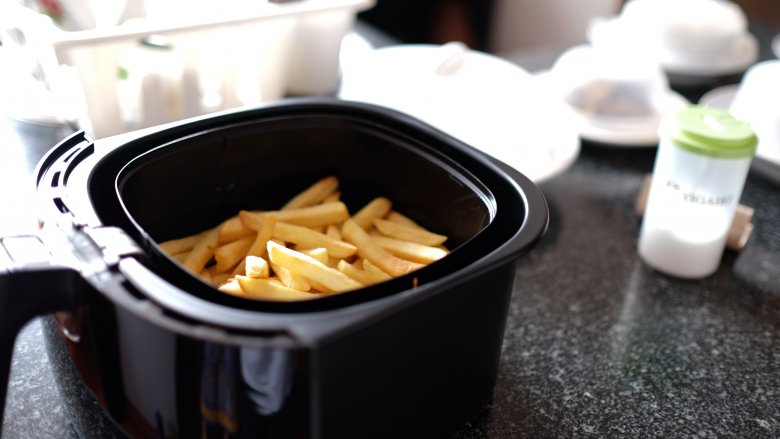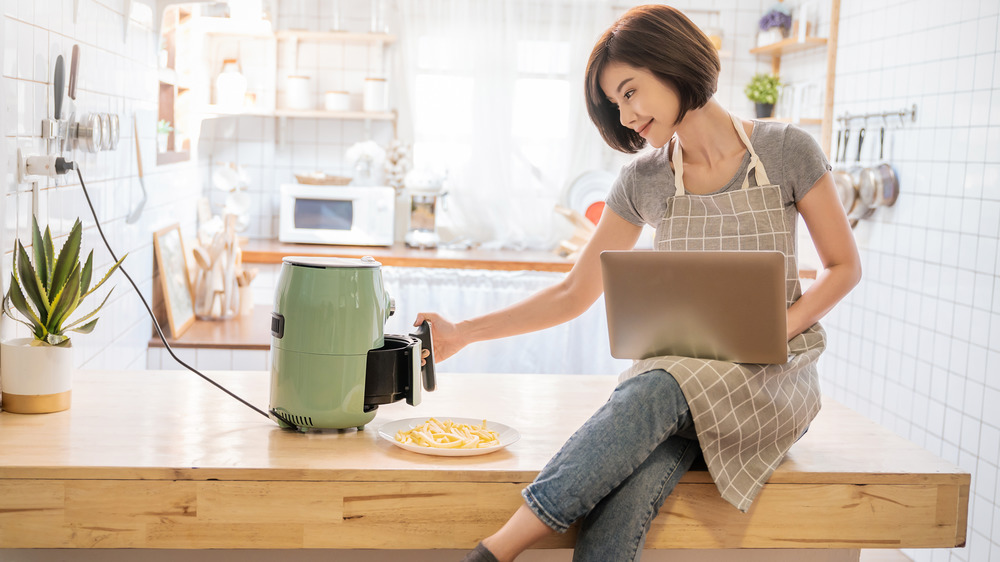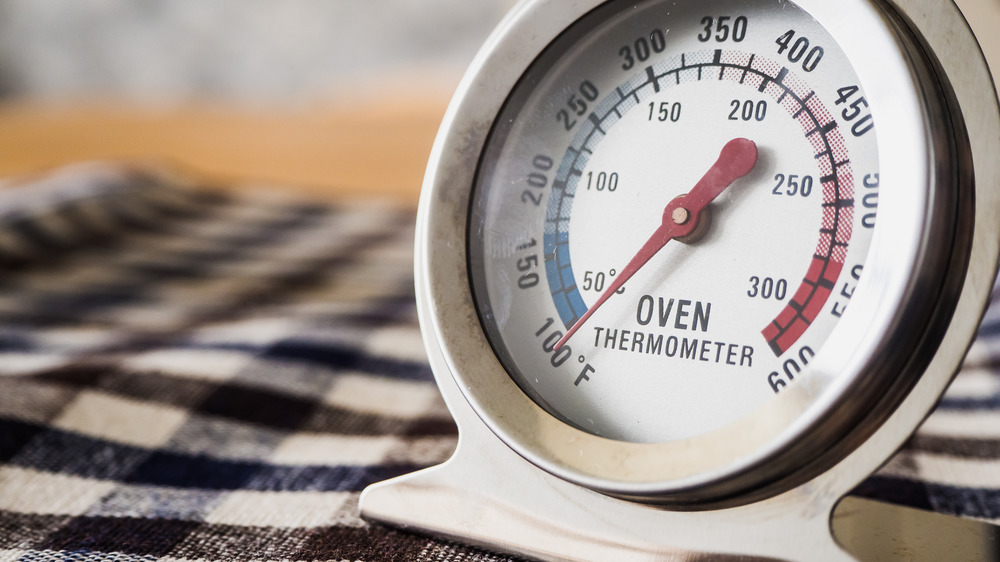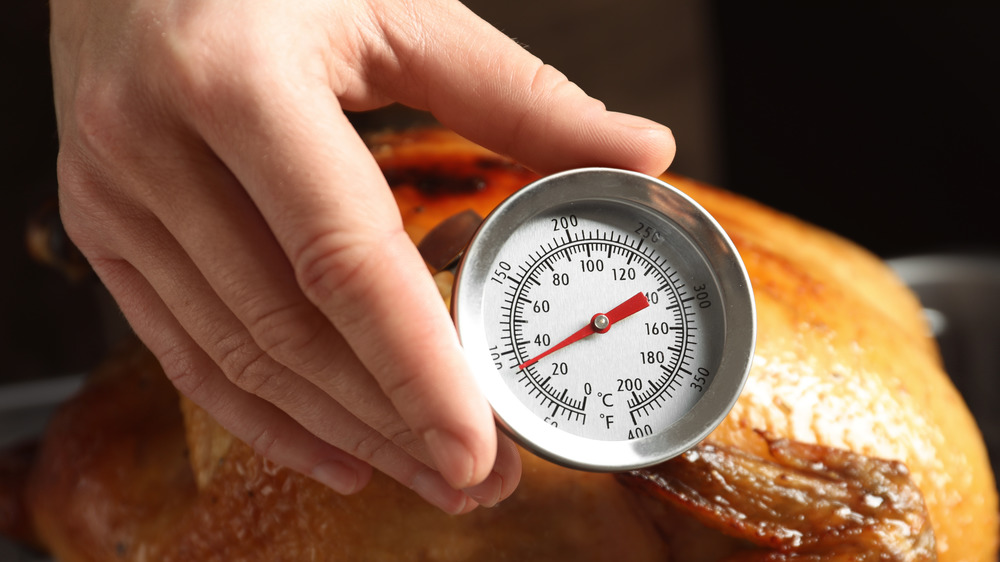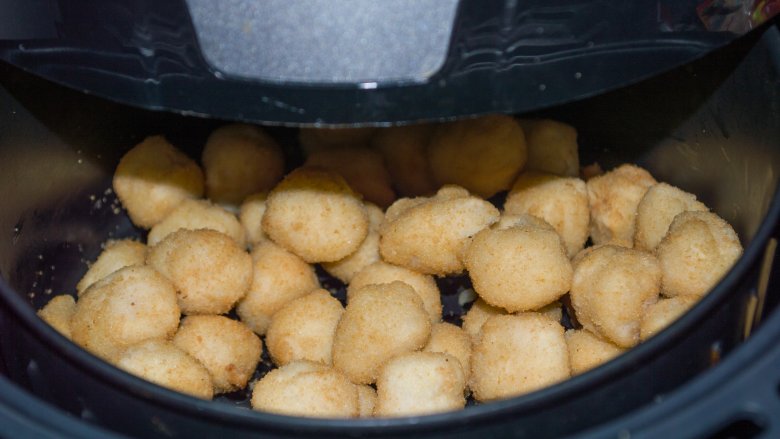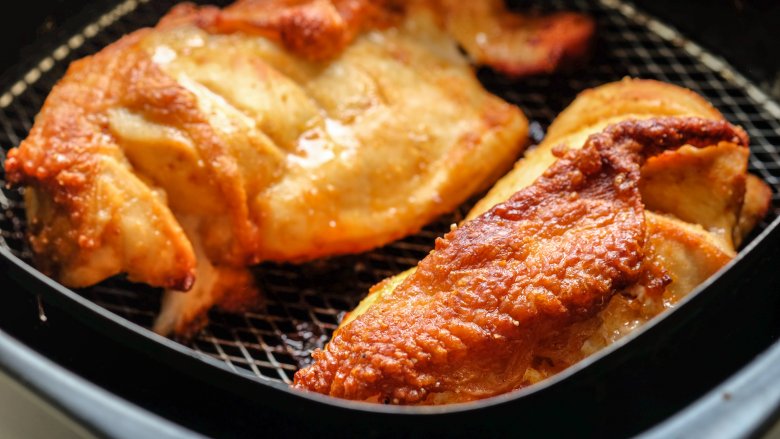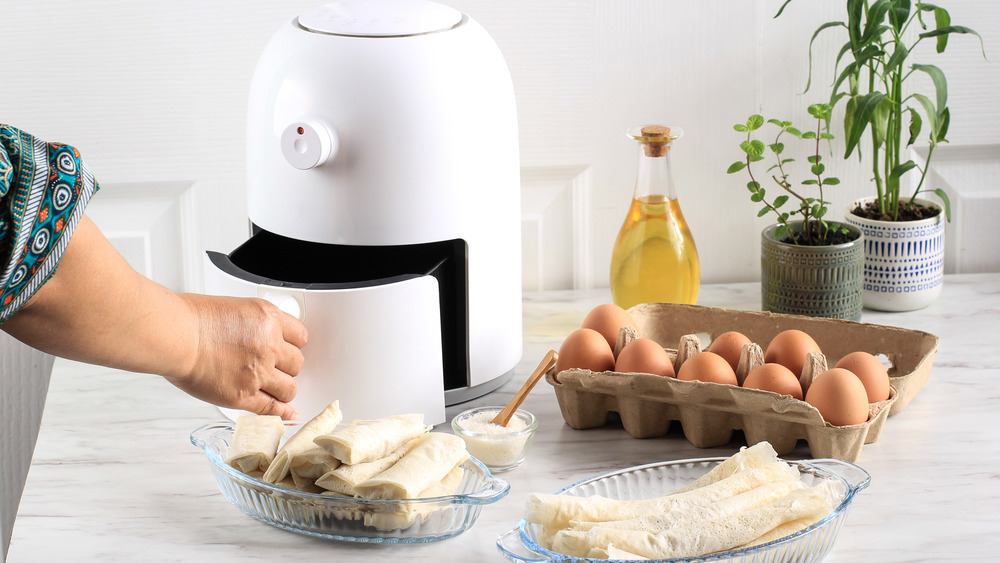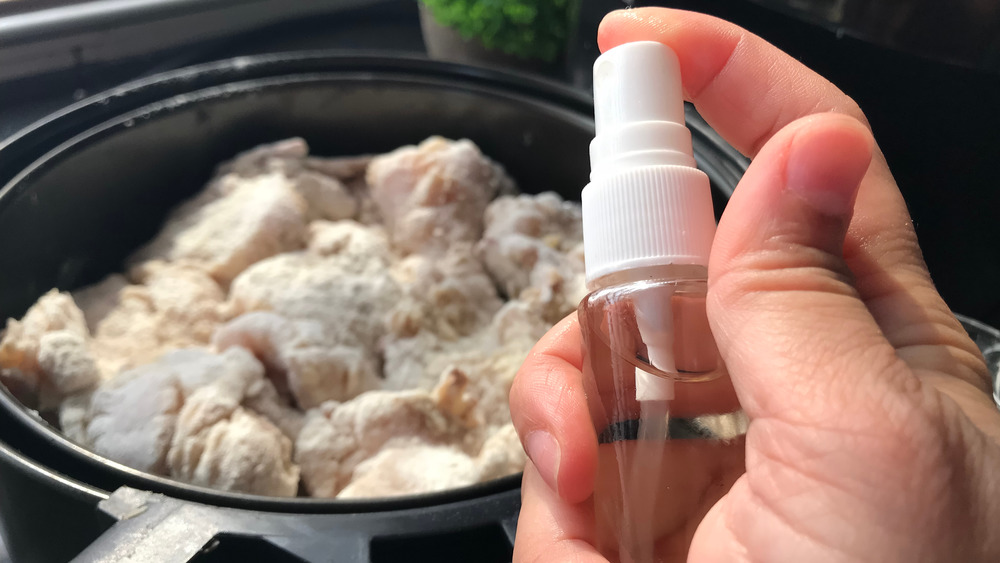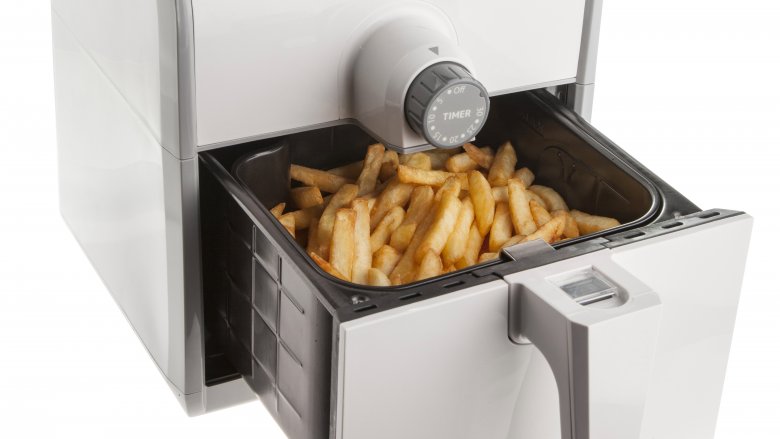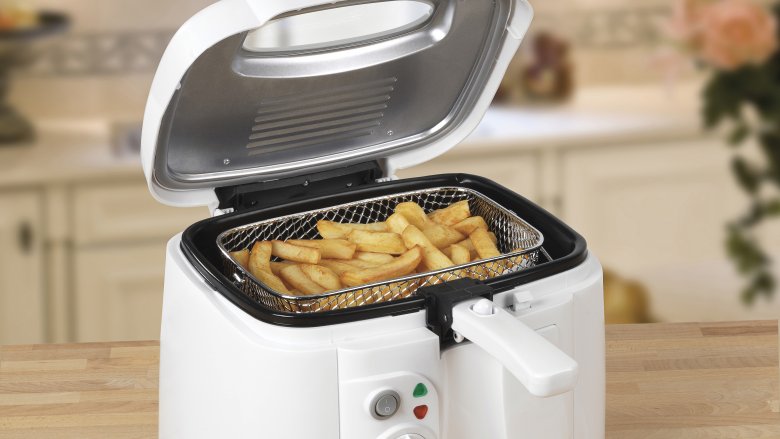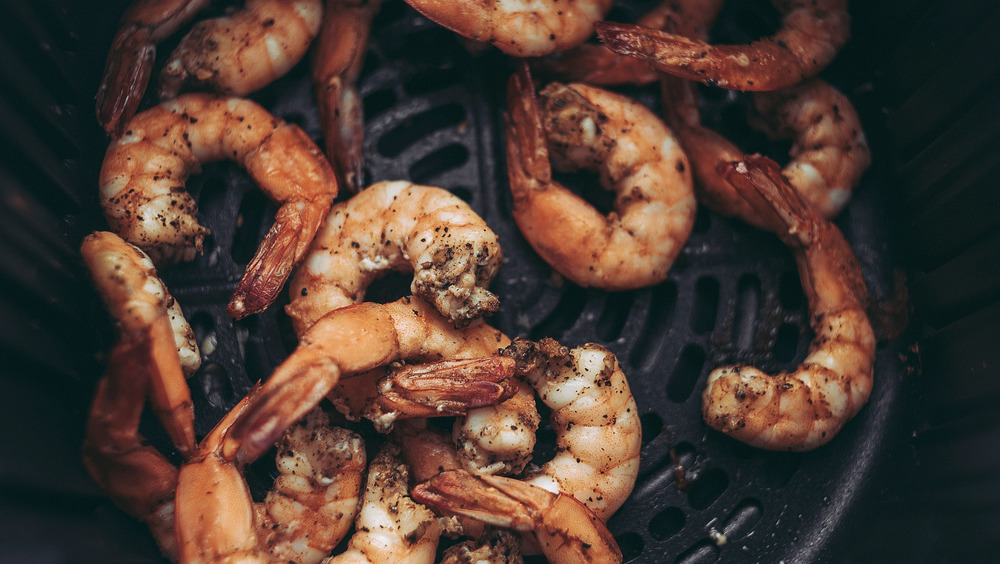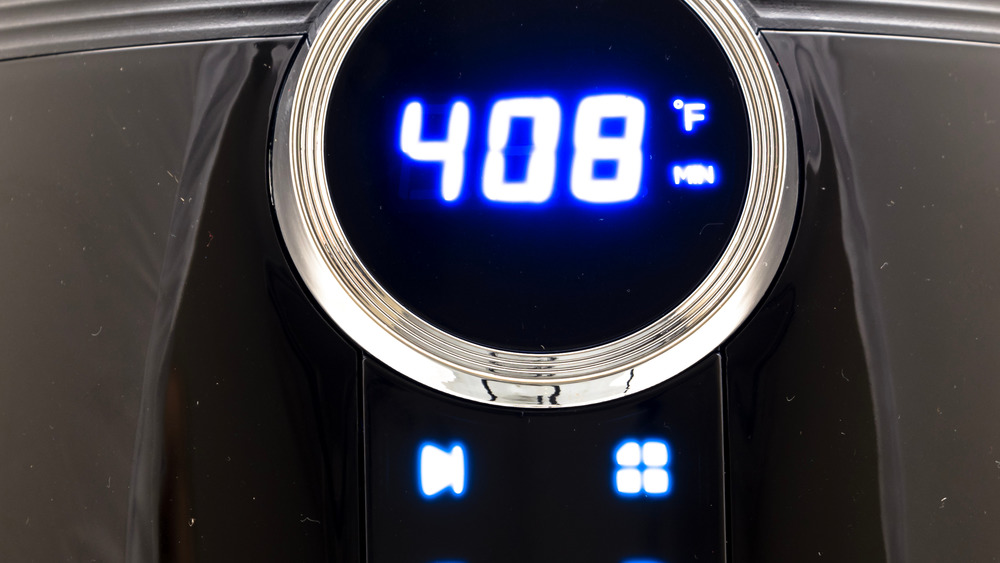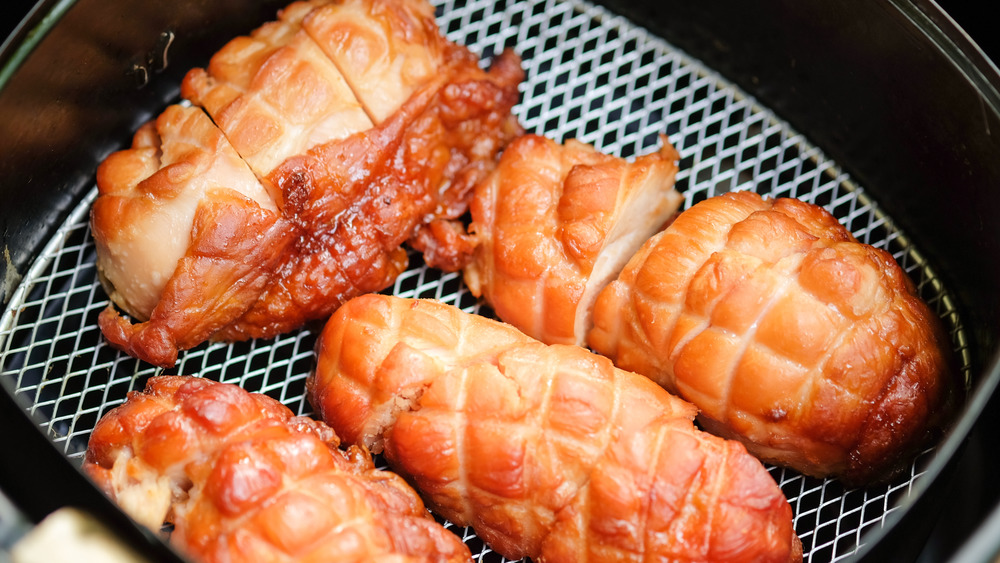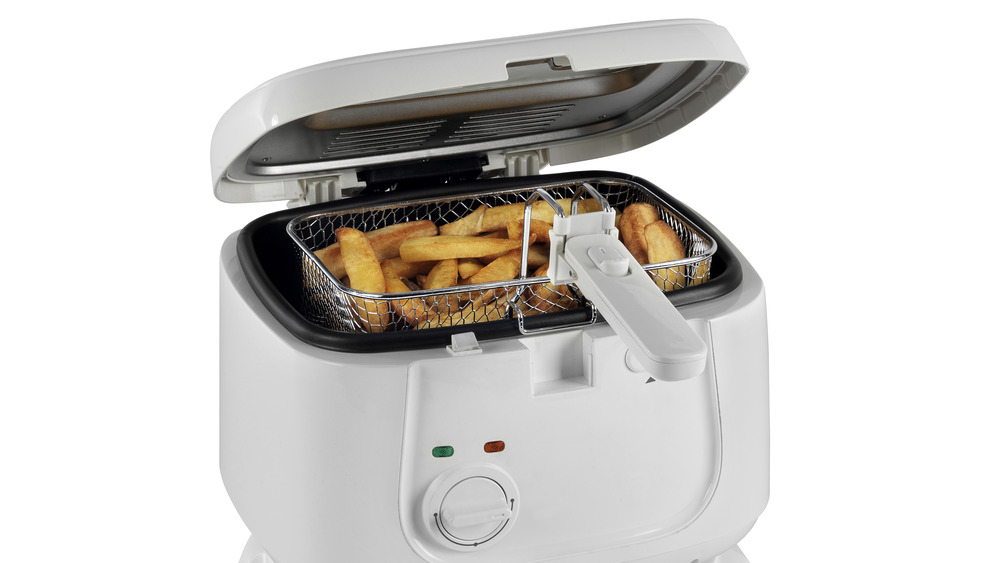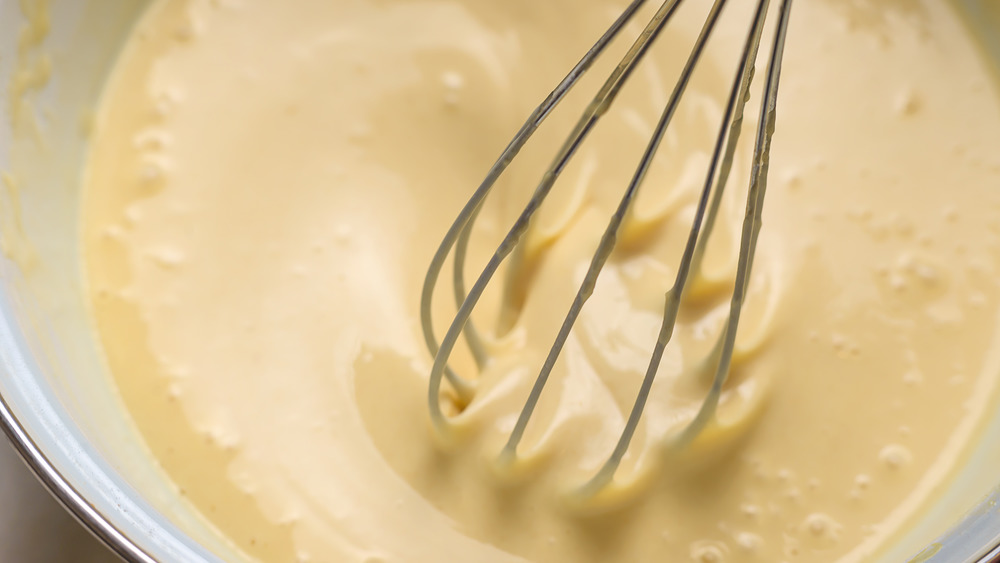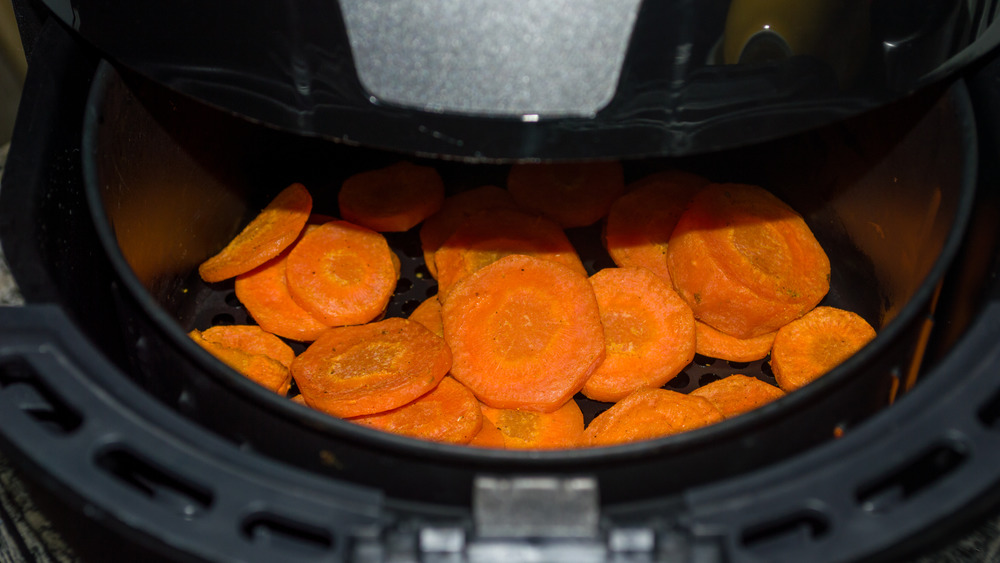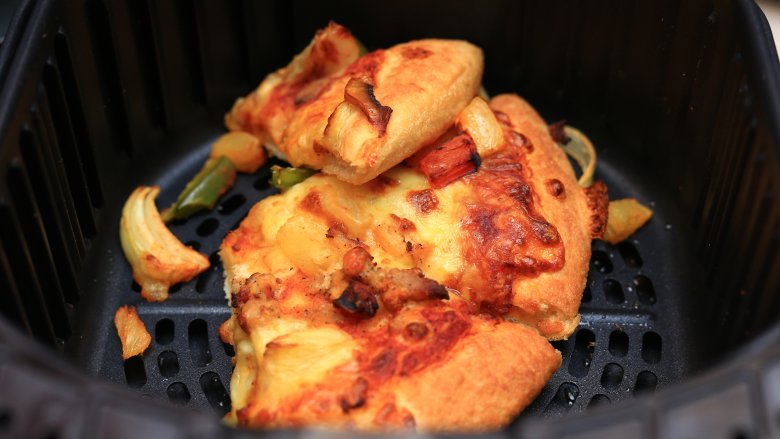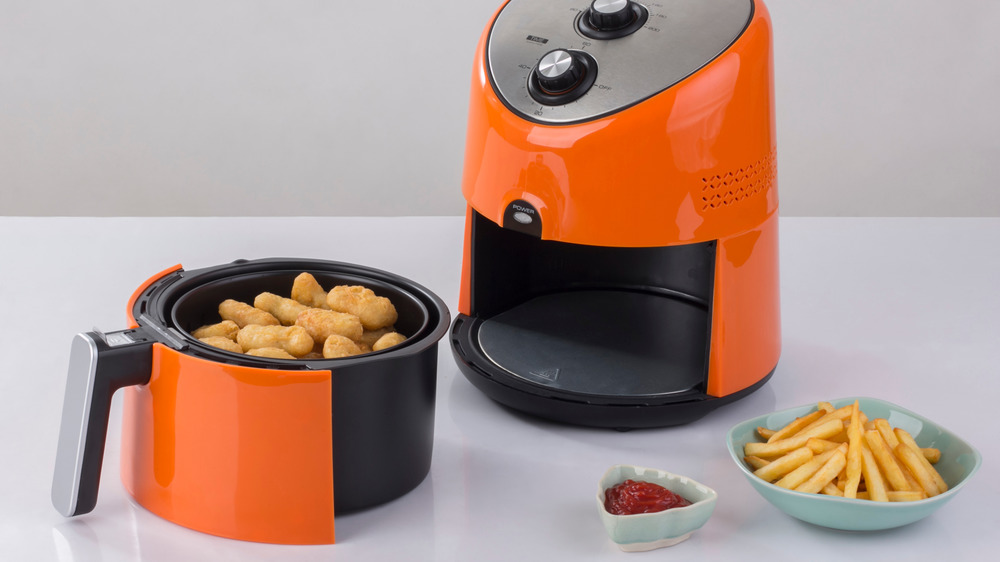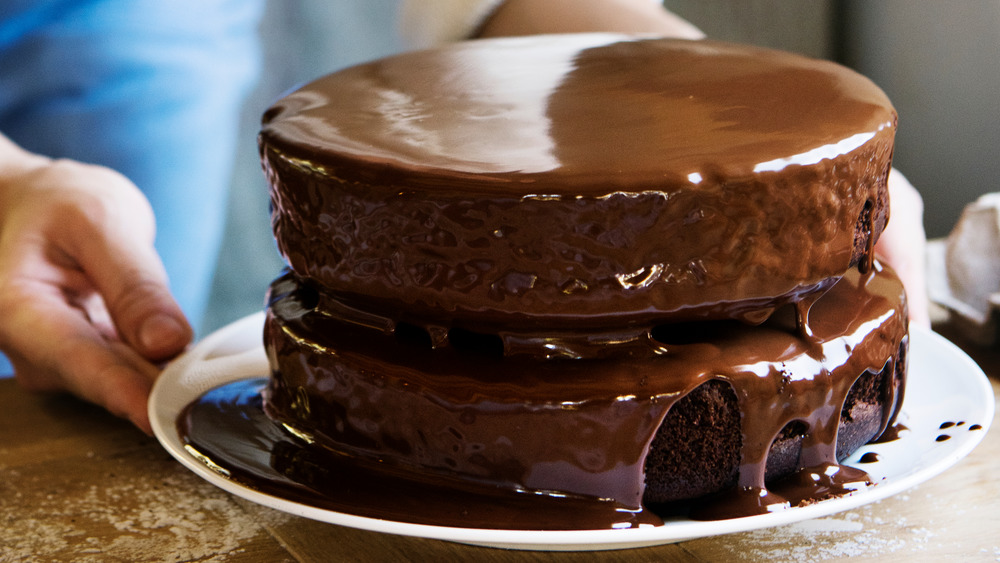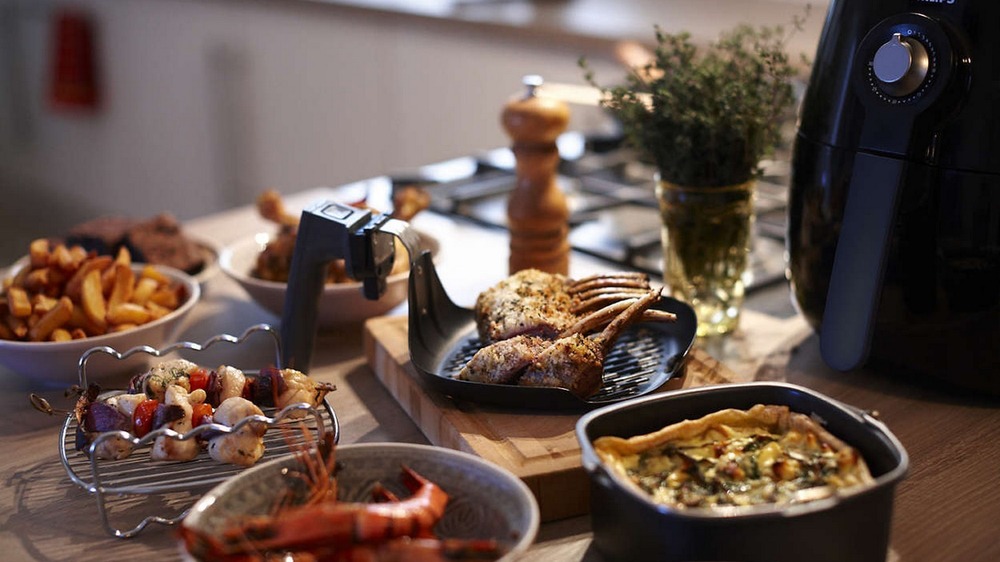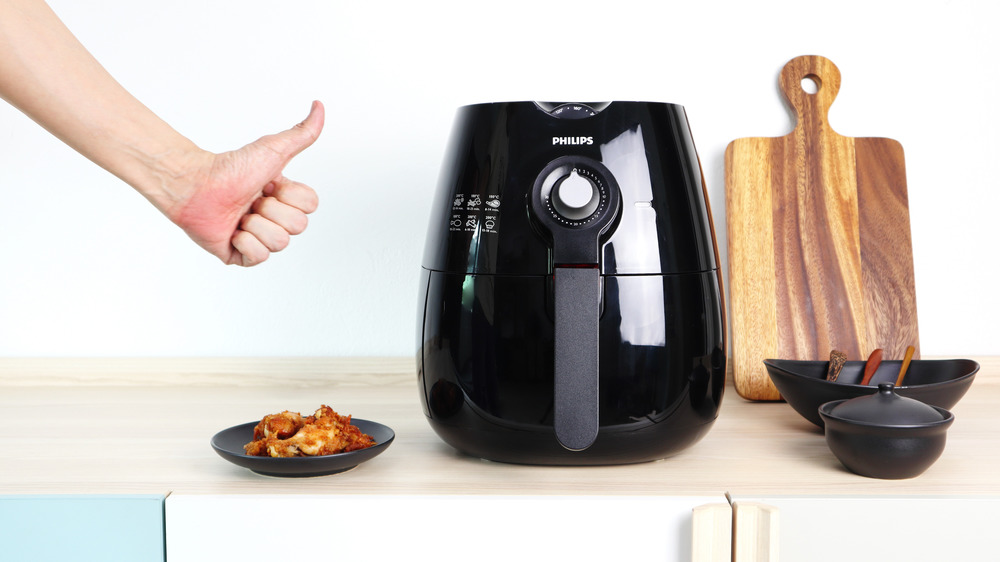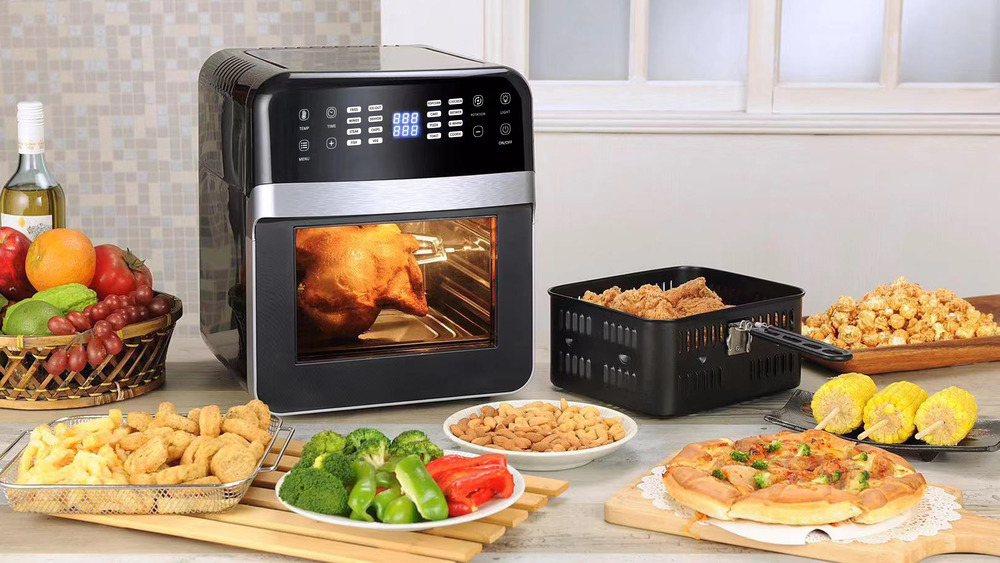Mistakes Everyone Makes With Air Fryers
There's nothing better than finding a kitchen appliance that seems like a miracle worker. Finally, you think, cooking dinner is going to be a breeze. No more wasting money on take-out or pricey delivered meal boxes. Then you get your new appliance, and...well, it's not what you expected.
Air fryers are one of the hottest new kitchen appliances, but you can't just turn it on, throw your food in, and be rewarded with a nice meal. There are a few tips and tricks you need to know before you start using your machine, or you could wind up in a worst-case scenario: a broken air fryer and a burnt dinner. It doesn't have to be this way!
These are just some of the common mistakes people make when they first start cooking with an air fryer. Avoid these pitfalls, and what can you expect from your air fryer? Your favorite crispy, golden brown foods made with way less oil than you're used to, and in a fraction of the time.
You're not adjusting for cooking times
While you don't have to build up a whole new recipe repertoire, assuming you can use your air fryer for old recipes while keeping things like temperature and cooking time the same is a pretty big mistake — one that can ruin dinner for sure.
According to Taste of Home, there are countless recipes that can be adapted to an air fryer, with just a few tweaks. For starters, they say that a good rule of thumb is to remember to lower the cooking temperature by 25 degrees Fahrenheit. Then, check out the recommended cooking time. You're going to want to take somewhere around 20 percent off that, and there's a bit of a catch.
When you're thinking of the time it takes to cook something in an air fryer, it's not always as clear-cut as you might be used to if you're cooking something on a stovetop. Different air fryers are going to have different cooking times, so depending on how your model, your cooking time might be a little more or less. Taste of Home says that French fries, for example, can take anywhere from 10 to 20 minutes. When you're getting used to a new air fryer or trying a new recipe, think of a cooking time as more of a guideline than something that's set in stone — and know that it's not going to take the same amount of time as other cooking methods.
You haven't checked the temperature of your air fryer
There's a lot we take for granted: we assume the sun's going to come up in the morning and set in the evening, that the McDonald's ice cream machine will be broken, and that Wendy's will always have a Frosty ready to satisfy your cravings.
We also tend to assume that the temperature settings on our kitchen appliances are correct, but that's not always the case.
Like... at all.
According to Taste of Home, the actual temperature that an air fryer runs at might not be near what you think you're setting it at. They found that different models ran either hotter or cooler, and that can mean the difference between crispy, delicious fries, and fries that are not-so-great.
Fortunately, double-checking the temp of your air fryer is pretty easy to do, and just requires the use of an oven thermometer (like the one pictured). And don't worry, this isn't just a one-time purchase that's going to get thrown in a drawer! Over time, the dials on your appliances can loosen and become much less precise. We found that it's best to check the temperature of your oven at least once every six months or so, in order to make sure you're actually cooking things at the temperature you think you are. Once you know, you can make any adjustments necessary.
You're not using a thermometer with your air fryer
No one wants a side of food poisoning along with their meal, and here's the thing: even though air fryers seem like a pretty foolproof way to cook, you should definitely be double-checking to make sure everything's reached the proper temperature before serving.
Brains Report tested a variety of air fryers, and found that they had one thing in common: they all took longer to get food properly cooked than most guidelines suggested. They recommended toasting a slice of bread as a test. Some air fryers could toast it in about 3 minutes, while others took up to 10. That's not a huge deal when you're talking about bread, but when you're talking about cooking chicken, it could mean the difference between enjoying a delicious meal, and getting up close and personal with salmonella.
So, when it comes to meats, you're going to want to not just eyeball it, but use a good, instant-read thermometer to make sure your meal is cooked all the way through. Take poultry. According to the USDA, all poultry needs to be cooked to a minimum internal temperature of 165 degrees Fahrenheit. That's when it's safe, and when it comes to food safety, it's better to be 100 percent sure you're on temperature — especially when you're using a cooking method that varies so wildly.
You don't use enough oil with your air fryer
It turns out it's sort of a misnomer to call an air fryer by its name, because you do in fact need to use oil when you cook with it. In the air fryer you really only need about 1-2 teaspoons for most items, or up to 1-2 tablespoons for breaded items that you want to get really crispy.
That's because, while the hot air racing through your machine will cook things, without oilthey can come out dry, burned, and leathery. Using just a touch of oil will help your food crisp up. This is especially true with fried and breaded items that you're heating up or cooking in your fryer — the oil on the outside of the food will get heated by the air, helping to cook the breaded items to a crispy golden brown.
If you're trying to avoid added fats in your diet, you can use a non-stick cooking spray or oil from a spray bottle to make sure you use just enough to coat your food. Just be sure to spritz your ingredients before you put them in your air fryer basket, which will help keep your machine clean.
You use too much oil in your air fryer
Now that you know yo still need oil in your air fryer, it can be easy to go too far in the other direction. For a lot of us, the impulse is to keep using the same amounts of oil as we do in traditional cooking methods, so that we can ensure everything comes out of the air fryer crispy and delicious.
But unlike with traditional frying, where you want your food to be submerged at least partially in oil, in the air fryer you really only need a little bit of oil (1-2 teaspoons for most foods) — more than that can lead to soggy, burned food, and is a fire hazard.
If your food isn't getting as crispy as you like, hold back on the temptation to add more oil – it's likely that it could be one of these other air fryer issues.
You're ignoring the smoke point of the oil you use in your air fryer
Air fryers get super hot inside, and while that kind of goes without saying, you might not be aware of the fact that can have a major impact on what oil you should — and shouldn't — be using with it.
Here are the basics: most of the time, you're going to be setting your air fryer somewhere at or between 350 and 400 degrees Fahrenheit. You're going to need just a dash of oil for most recipes, and according to Air Frying, that all means you should make sure you're only using oils with a smoke point high enough they're not going to burn.
Some commonly used oils — like EVOO — have smoke points well below what you're going to be setting your air fryer at, so they're not suitable for this application.
But don't worry, there's good news: this is the perfect opportunity to reach for some bottles of equally awesome oils. Avocado, peanut, sesame, safflower, and sunflower oil all have smoke points well above that 400 degree mark, and that makes them excellent options. Just... skip the olive oil, ok?
You're using PAM in your air fryer
There are some things that just have a permanent place in kitchens across the country, and PAM is one of those things. This non-stick cooking spray can be a lifesaver (or, at least, a time- and sanity-saver), and it's easy to see how you might be tempted to pull out that aerosol can and see if it'll make cleaning up your air fryer a little easier.
Don't!
Air Cookers notes that most air fryers already have nonstick coatings, and these coatings can actually be damaged by the additives in some aerosol sprays. (Remember when aerosol cans and their CFCs were banned in the late 1970s because it was found they were destroying the environment? Scientific American says they haven't gotten any less controversial — or much safer.)
Some propellants currently in use will cause nonstick coatings to flake, and if you've noticed this happening with your pans, it's entirely possible your PAM habit is to blame. Fortunately, there's a quick fix: pick up a non-aerosol pump sprayer or mister bottle like the one pictured, and use it to add a mist of your favorite oil to not just your air fryer basket, but countless other cooking projects.
You overcrowd the air fryer pan
There are some hints you can take from traditional frying when you use your air fryer. One of the most important rules? If you want your food to cook evenly, you can't overcrowd the air fryer.
If you add too much food to the air fryer basket or pan, you'll wind up with a mess — food that's half burnt, half undercooked, and not tasty at all. Instead, cook your food in batches, like you would if you were frying things in a pan of hot oil. It's recommended that you never fill your air fryer more than half way, so keep that in mind when you're planning your meals. It's tempting to cram everything in there, especially if you're hungry, but your best bet is either sizing up to one of the larger models that can handle more food, or patiently cooking in batches. Luckily, even if you do cook in batches, the air fryer is often speedier than a regular frying pan, meaning you'll still save time.
You don't give your air fryer room to vent
Have you ever sat a laptop computer on a cushion or soft surface, only to have it spontaneously shut down from overheating? Powerful motors need to have adequate ventilation, and the same principal applies with your air fryer.
Yes, you may have the perfect little countertop nook all set up for your air fryer ready, but unless it allows the fryer to have at least five inches of space on all sides while it's in use, it's not safe to use it while it's there.
If you're having trouble finding a spot that does allow your machine to properly vent, try storing it in that cute little nook... but using someplace much more safe (likely right in the middle of your favorite work space).
Adequate ventilation will ensure that your machine runs smoothly (meaning your food will cook more evenly), and prevents fire hazards. On that note, you should also make sure your fryer is on a stable, flat, heat-proof surface when you use it — and never, ever use it on your stove.
You don't clean your air fryer often enough
It's tempting to just use your air fryer time and time again without cleaning it in between cooking sessions, especially since, unlike traditional frying, you're not left with a slopping pan of oil to clean up. But that would be a mistake.
A number of problems can arise if you don't clean your air fryer often enough. Crumbs and food particles left behind in the basket can burn the next time you use your fryer, leftover oil residue in the drawer can smoke, imparting your food with off flavors and posing a fire hazard, and it can start to stink, making your kitchen smell foul.
Instead of putting it off until next time, you should hand wash the air fryer basket, bottom tray, and drawer with warm water and dish soap after every session. All of the pieces should remove easily from your machine. Your machine will stay running smoothly, so you can keep cooking your favorite foods.
You don't preheat your air fryer
There's no such thing as a miracle product, so there are some things you need to do to make sure your air fryer works like a charm. You can't just throw your food in and then set the temperature — as with most other cooking methods, you need to preheat the air fryer before you use it. If you put a potato wedge in a cold pan of oil, it'll be a greasy, beige mess when it's cooked through. The same is true of food made in the air fryer.
You should preheat your air fryer for ten minutes before you start cooking. Use that time to chop veggies and bread meats, or to catch a few more minutes of your favorite Netflix show.
Preheating the air fryer will ensure that the ingredients in your basket start cooking immediately, crisping up on the outside instead of slowly steaming into a soggy mess. By the time your food is properly crisped outside, it will be steamy and tender inside, thanks to that quick preheat.
You let seasonings fly
Fried foods are nothing without seasoning (neither are vegetables, for that matter), so you'll likely want to add a hefty pinch or sprinkle of your favorite spices to anything you make in the air fryer. However, you need to be careful.
The air fryer works through convection, aggressively pushing hot air around your food to cook it. This means any seasoning that isn't fully adhered to your ingredients can end up getting caught up by the rush of air, leaving you with unseasoned food and a filthy air fryer.
The same goes for crispy coatings and and other light ingredients.
To ensure that you don't wind up with a flying salt and pepper disaster, be mindful about when you season. For instance, spray veggies with oil before adding seasoning, so it has something to stick to, or season the flour, beaten egg, and crispy coating directly when making chicken tenders and the like, instead of sprinkling them with seasoning after breading.
You'll also need to secure top slices of bread on sandwiches, leafy things like fresh herbs or spinach, and other light ingredients. In these cases, a toothpick will do the trick.
You set your air fryer and forget it
The air fryer is a lot simpler than deep frying food on the stove, but there are some things you still need to do. You can't just put your food in, walk away, and expect to have a perfectly cooked meal when the timer dings. This isn't a Showtime Rotisserie — you can't "set it and forget it"!
Firstly, for best results, you need to flip your foods halfway through cooking, to make sure they crisp up evenly on both sides. If they're not browning as well as you like, you can add a little more oil to your food. You can also open the fryer at any time to check for the doneness of your ingredients.
Secondly, leaving your air fryer unattended can be a fire hazard. Check in periodically for any signs of trouble. Black smoke usually means there's food burning inside, while white smoke means excess oil or grease is too hot and in danger of catching fire. To prevent oil from catching, pour some water into the air fryer drawer to keep things cool during cooking.
You try to use traditional frying batters in your air fryer
Maybe your favorite churro recipe uses a batter, or you're used to dunking hot dogs into a thick cornmeal sludge before making your famous hot dogs. Well, if you want to keep using loose batters to bread your foods, you'll need to stick to traditional pan- and deep-frying; if you try to put ingredients covered in a wet batter in your air fryer, the batter will sink through the basket and wind up burning in the drawer below, while you end up with naked hot dogs and no churros at all.
Instead, make crispy fried foods by using dry breadings (like breadcrumbs or seasoned flour) or doughs.
Many swear that a classic a three-part breading process works best in the air fryer. First, coat your ingredient in seasoned flour, then dip it in beaten egg, and finally, coat it in breadcrumbs. Spritz each piece lightly with oil, and cook in your air fryer until done.
Your result? Golden-brown, crispy air fried foods that have less fat than their traditionally made counterparts, but just as much flavor (and that satisfying "crunch!" when you take your first bite).
You try cooking raw vegetables in the air fryer
If you got your air fryer because you're trying to eat healthier foods, like unprocessed, fresh veggies, you might be surprised to hear this next fact. You're better off using frozen vegetables in your air fryer, not fresh.
Unfortunately, raw veggies tend to scorch in the air fryer before the insides can be cooked all the way through. Frozen vegetables, on the other hand, have more moisture. This allows them to cook fully before starting to brown, so you don't wind up with a charred exterior and frozen interior.
Luckily, most frozen veggies are frozen at the peak of freshness, so you still get the same robust flavor you'd expect when cooking a raw vegetable — sometimes even better.
Another air fryer veggie mistake? Cutting vegetables too small. Make sure any vegetables you put in the fryer are at least 1/4 inch wide, so that they don't fall through the basket. If you want to air fry things like peas or corn, add them to a pan that fits inside your fryer basket so they stay secure while cooking.
You don't use your air fryer for leftovers
How many times have you microwaved or baked your leftover pizza, orange chicken, or french fries, only to be greeted with a plate of food that's soggy when it should be crispy, burnt and hard when it should be soft, and leathery and tough when it should be tender? All of those leftovers end up going to waste — in fact, leftovers make up the bulk of edible foods we throw away each year, so figuring out how to make them palatable again is good for your wallet and the environment.
The air fryer is a champ when it comes to reheating your favorite leftovers. Pizza stays crispy on the bottom while melting the cheese on top, tater tots and fries are re-crisped to perfection; pretty much any solid food (read: not soups, stews, or wet noodle dishes like spaghetti) is better reheated in the air fryer than anywhere else.
You only use your air fryer for fried foods
With a name like air fryer, it's understandable that some people think you can only make fried foods, leftover or made from frozen, in one of these devices. Luckily for the more adventurous gastronomes among us, this isn't the case.
While frozen and leftover fried foods you're reheating both do taste delicious when you make them in your air fryer, it's even better for making crispy breaded foods from scratch. You'll be able to customize the recipe to your liking (meaning you can skip the additives, preservatives, and high sodium found in most frozen foods), and will wind up with much crispier food than if you baked in the oven. Better yet, your foods will still be lower in fat than if you fried them in the traditional manner. Try breading pork chops or fish, or making a fresh batch of chicken Parmesan in your air fryer to save time (and oven space).
You're not baking with your air fryer
One of the reasons why air fryers are such a great tool in the kitchen is that they're versatile. It turns out you can even make your favorite baked goods in one.
Why make baked goods in the air fryer? It doesn't use up as much energy as heating up your entire oven, and in the warmer months, it's one way to make sure that you aren't turning your house into an oven just because you were craving chocolate cake.
The other reason? It's easy to convert conventional oven recipes into air fryer recipes when it comes to baked goods. Set your air fryer to the same temperature as the original recipe calls for, and cook your items for the same amount of time.
The one thing you will need to be conscious of is the size of your air fryer. Some have round baskets, others have square, so you need to be mindful of which inserts you can use inside your fryer. Remember too that ramekins and silicone molds can also be used in your air fryer to make individual-sized desserts that will cook up quickly. And on that note, you do always need to use some sort of pan or insert when baking in the air fryer — if not, batter and dough will seep through the holes at the bottom of your air fryer basket, burning and creating a potential fire hazard.
You're not using accessories in your air fryer
Most air fryers come with a basic basket, and that's all you'll need to make classic favorites like french fries, frozen fried foods, and many reheated leftovers. But if you really want to get your money's worth out of the air fryer, investing in some accessories will help.
As we've already noted, your air fryer should always be set on a heat-proof surface. If your countertop isn't made to withstand high temperatures, you'd be wise to invest in a silicone mat to set your air fryer on before you start cooking. One of those is a lot more affordable than replacing your entire countertop.
There are accessories that go inside the air fryer that can make it more useful too. Look for cake pans, silicone molds, ramekins, racks, and other cooking devices that can fit inside your air fryer basket. These will help you make a much wider variety of foods in your air fryer without having to worry about spillage, overflow, or burning, so you can get as much use out of your new device as possible.
Also be on the lookout for things that make cleaning up your air fryer easier. This includes oil sprayers, which will help prevent stuck-on food, and parchment paper lines, which keep the bottom of your fryer clean. The easier it is to take care of, the more inclined you'll be to use it.
You're not drying your air fryer completely
It doesn't matter how much you like to cook, there's one universal truth that goes along with that: no one likes to be the one to clean up. And sure, air fryers might be convenient, but they can be a hassle to clean. As easy as it might be to take a shortcut at the end, you shouldn't.
Getting the basket and drawer of an air fryer clean is a pain, and getting them dry is even more of a pain... if, that is, you're using a towel. There's no need! In order to get your air fryer completely dry — and avoid that almost inevitable, slightly funky smell you'll notice if you leave something sitting — sealed — on your countertop for a bit, Blue Jean Chef says there's an easy fix. After giving it a thorough scrub, replace both the basket and the dryer, and turn your air fryer on for just a few minutes. All that extra moisture? Gone!
You bought a cheap air fryer
If you've tried every trick in the book, taken every bit of advice you've been given, and are still having trouble getting your air fryer meals to come out as good as everyone else swears theirs do, here's some good news: it might not be anything you're doing at all.
Which is a consumer watchdog and advocate group in the UK, and they looked at air fryers to see how price impacted quality.
They found that in many cases, price did make a difference. While there were some cheap air fryers out there that got the job done when it came to something like a single serving of fries, spending a little more money made a huge difference when it came to things like capacity, the versatility of being able to cook more than one thing at a time, and smart controls. If you went cheap, you might find yourself dealing with a model that doesn't even have a power cord long enough to safely position it in your kitchen, and that's not good.
BBC Good Food found similar things. When they tested a series of air fryers, they found one decent budget model, while all their other recommendations were between £100 and £250.
The bottom line seems to be that if you went on the cheap side for your air fryer, there's a good chance it might not put out a satisfactory meal even if you do everything right. An upgrade might be in order!
